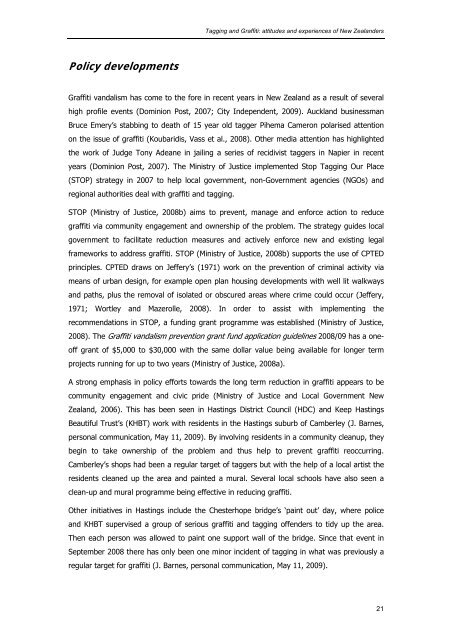Tagging and Graffiti - Victoria University of Wellington
Tagging and Graffiti - Victoria University of Wellington
Tagging and Graffiti - Victoria University of Wellington
You also want an ePaper? Increase the reach of your titles
YUMPU automatically turns print PDFs into web optimized ePapers that Google loves.
<strong>Tagging</strong> <strong>and</strong> <strong>Graffiti</strong>: attitudes <strong>and</strong> experiences <strong>of</strong> New Zeal<strong>and</strong>ers<br />
Policy developments<br />
<strong>Graffiti</strong> v<strong>and</strong>alism has come to the fore in recent years in New Zeal<strong>and</strong> as a result <strong>of</strong> several<br />
high pr<strong>of</strong>ile events (Dominion Post, 2007; City Independent, 2009). Auckl<strong>and</strong> businessman<br />
Bruce Emery’s stabbing to death <strong>of</strong> 15 year old tagger Pihema Cameron polarised attention<br />
on the issue <strong>of</strong> graffiti (Koubaridis, Vass et al., 2008). Other media attention has highlighted<br />
the work <strong>of</strong> Judge Tony Adeane in jailing a series <strong>of</strong> recidivist taggers in Napier in recent<br />
years (Dominion Post, 2007). The Ministry <strong>of</strong> Justice implemented Stop <strong>Tagging</strong> Our Place<br />
(STOP) strategy in 2007 to help local government, non-Government agencies (NGOs) <strong>and</strong><br />
regional authorities deal with graffiti <strong>and</strong> tagging.<br />
STOP (Ministry <strong>of</strong> Justice, 2008b) aims to prevent, manage <strong>and</strong> enforce action to reduce<br />
graffiti via community engagement <strong>and</strong> ownership <strong>of</strong> the problem. The strategy guides local<br />
government to facilitate reduction measures <strong>and</strong> actively enforce new <strong>and</strong> existing legal<br />
frameworks to address graffiti. STOP (Ministry <strong>of</strong> Justice, 2008b) supports the use <strong>of</strong> CPTED<br />
principles. CPTED draws on Jeffery’s (1971) work on the prevention <strong>of</strong> criminal activity via<br />
means <strong>of</strong> urban design, for example open plan housing developments with well lit walkways<br />
<strong>and</strong> paths, plus the removal <strong>of</strong> isolated or obscured areas where crime could occur (Jeffery,<br />
1971; Wortley <strong>and</strong> Mazerolle, 2008). In order to assist with implementing the<br />
recommendations in STOP, a funding grant programme was established (Ministry <strong>of</strong> Justice,<br />
2008). The <strong>Graffiti</strong> v<strong>and</strong>alism prevention grant fund application guidelines 2008/09 has a one<strong>of</strong>f<br />
grant <strong>of</strong> $5,000 to $30,000 with the same dollar value being available for longer term<br />
projects running for up to two years (Ministry <strong>of</strong> Justice, 2008a).<br />
A strong emphasis in policy efforts towards the long term reduction in graffiti appears to be<br />
community engagement <strong>and</strong> civic pride (Ministry <strong>of</strong> Justice <strong>and</strong> Local Government New<br />
Zeal<strong>and</strong>, 2006). This has been seen in Hastings District Council (HDC) <strong>and</strong> Keep Hastings<br />
Beautiful Trust’s (KHBT) work with residents in the Hastings suburb <strong>of</strong> Camberley (J. Barnes,<br />
personal communication, May 11, 2009). By involving residents in a community cleanup, they<br />
begin to take ownership <strong>of</strong> the problem <strong>and</strong> thus help to prevent graffiti reoccurring.<br />
Camberley’s shops had been a regular target <strong>of</strong> taggers but with the help <strong>of</strong> a local artist the<br />
residents cleaned up the area <strong>and</strong> painted a mural. Several local schools have also seen a<br />
clean-up <strong>and</strong> mural programme being effective in reducing graffiti.<br />
Other initiatives in Hastings include the Chesterhope bridge’s ‘paint out’ day, where police<br />
<strong>and</strong> KHBT supervised a group <strong>of</strong> serious graffiti <strong>and</strong> tagging <strong>of</strong>fenders to tidy up the area.<br />
Then each person was allowed to paint one support wall <strong>of</strong> the bridge. Since that event in<br />
September 2008 there has only been one minor incident <strong>of</strong> tagging in what was previously a<br />
regular target for graffiti (J. Barnes, personal communication, May 11, 2009).<br />
21
















